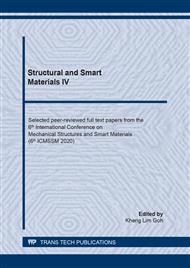[1]
P.V. Baptista, et al., Nano-Strategies to Fight Multidrug Resistant Bacteria-A Battle of the Titans,, Front. Microbiol. 9 (2018) 1-26.
Google Scholar
[2]
C.H. Barros, S. Fulaz, D. Stanisic, L. Tasic, Biogenic nanosilver against multidrug-resistant bacteria (MDRB), Antibiotics 7 (2018) 69.
DOI: 10.3390/antibiotics7030069
Google Scholar
[3]
V.K. Sharma, R.A. Yngard, Y. Lin, Silver nanoparticles: Green synthesis and their antimicrobial activities, Adv. Colloid Interface Sci. 145 (2009) 83-96.
DOI: 10.1016/j.cis.2008.09.002
Google Scholar
[4]
N.T. Nguyen, J.H. Liu, Wet Chemical Synthesis of Silver Nanowires Based on a Soft Template of Cholesteryl Pyridine Carbamate Organogel, Sci. Adv. Mater. 7 (2015) 1282-1290.
DOI: 10.1166/sam.2015.2042
Google Scholar
[5]
N.T. Nguyen, J.H. Liu, A green method for in situ synthesis of poly(vinyl alcohol)/chitosan hydrogel thin films with entrapped silver nanoparticles, J. Taiwan Inst. Chem. Eng. 45 (2014) 2827-2833.
DOI: 10.1016/j.jtice.2014.06.017
Google Scholar
[6]
P. Sharma, P.J. Babu, U. Bora, Sapindus mukorossi aqueous fruit extract as reducing, capping and dispersing agents in synthesis of gold nanoparticles, Micro Nano Lett. 7(12) (2012) 1296-1299.
DOI: 10.1049/mnl.2012.0684
Google Scholar
[7]
S. Hemmati, A. Rashtiani, M.M. Zangeneh, P. Mohammadi, A. Zangeneh, H. Veisi, Green synthesis and characterization of silver nanoparticles using Fritillaria flower extract and their antibacterial activity against some human pathogens, Polyhedron 158 (2019) 8-14.
DOI: 10.1016/j.poly.2018.10.049
Google Scholar
[8]
M.S. Muthuraman, S. Nithya, V. Vinoth kumar, L.R. Christena, V. Vadivel, N.S. Subramanian, S.P. Anthony, Green synthesis of silver nanoparticles using Nardostachys jatamansi and evaluation of its anti-biofilm effect against classical colonizers, Microb. Pathog. 126 (2019) 1-5.
DOI: 10.1016/j.micpath.2018.10.024
Google Scholar
[9]
C. Vishwasrao, B. Momin, L. Ananthanarayan, Green Synthesis of Silver Nanoparticles Using Sapota Fruit Waste and Evaluation of Their Antimicrobial Activity, Waste Biomass Valorization 10 (2019) 2353-2363.
DOI: 10.1007/s12649-018-0230-0
Google Scholar
[10]
S. Das, R. Parida, I. Sriram Sandeep, S. Nayak, S. Mohanty, Biotechnological intervention in betelvine (Piper betle L.): A review on recent advances and future prospects, Asian Pac. J. Trop. Med. 9 (2016) 938-946.
DOI: 10.1016/j.apjtm.2016.07.029
Google Scholar
[11]
S. Khan, S. Singh, S. Gaikwad, N. Nawani, M. Junnarkar, S.V. Pawar, Optimization of process parameters for the synthesis of silver nanoparticles from Piper betle leaf aqueous extract, and evaluation of their antiphytofungal activity, Environ. Sci. Pollut. Res. 27 (2020) 27221-27233.
DOI: 10.1007/s11356-019-05239-2
Google Scholar
[12]
R. Srinivasan, et al., Biogenic synthesis of silver nanoparticles using Piper betle aqueous extract and evaluation of its anti-quorum sensing and antibiofilm potential against uropathogens with cytotoxic effects: an in vitro and in vivo approach, Environ. Sci. Pollut. Res. 25 (2018) 10538-10554.
DOI: 10.1007/s11356-017-1049-0
Google Scholar
[13]
P. Usha Rani, P. Rajasekharreddy, Green synthesis of silver-protein (core–shell) nanoparticles using Piper betle L. leaf extract and its ecotoxicological studies on Daphnia magna, Colloids Surf. A Physicochem. Eng. Asp. 389 (2011) 188-194.
DOI: 10.1016/j.colsurfa.2011.08.028
Google Scholar
[14]
Clinical, L.S. Institute, Methods for dilution antimicrobial susceptibility tests for bacteria that grow aerobically, Approved standard M7-A7, 26 (2006).
Google Scholar
[15]
D. Tripathi, A. Modi, G. Narayan, S.P. Rai, Green and cost effective synthesis of silver nanoparticles from endangered medicinal plant Withania coagulans and their potential biomedical properties, Mater. Sci. Eng. C, 100 (2019) 152-164.
DOI: 10.1016/j.msec.2019.02.113
Google Scholar


